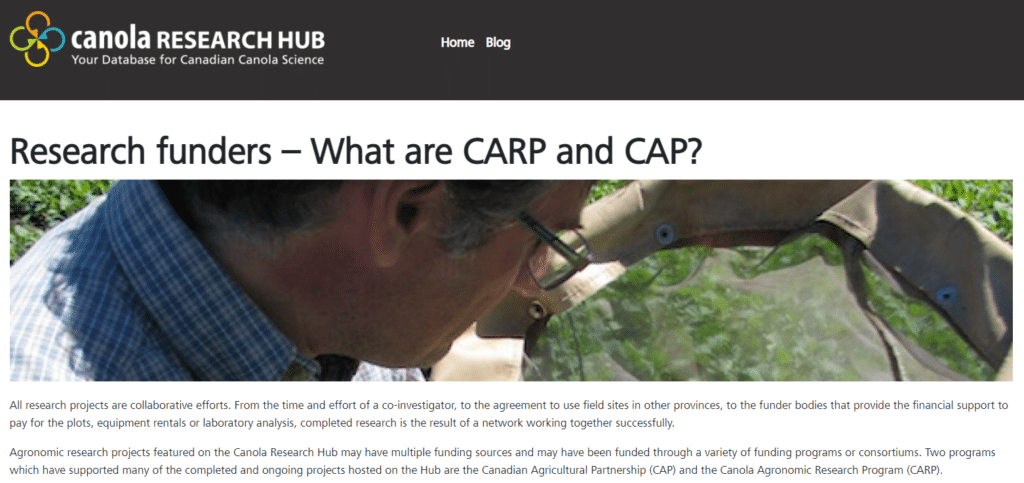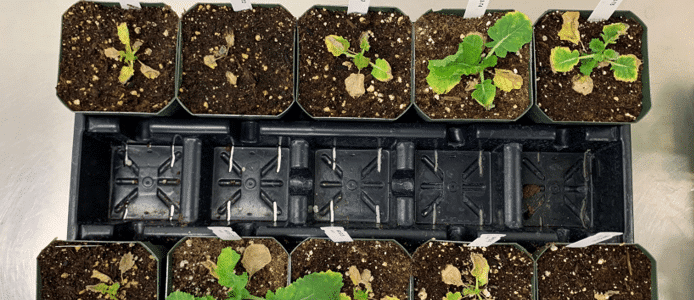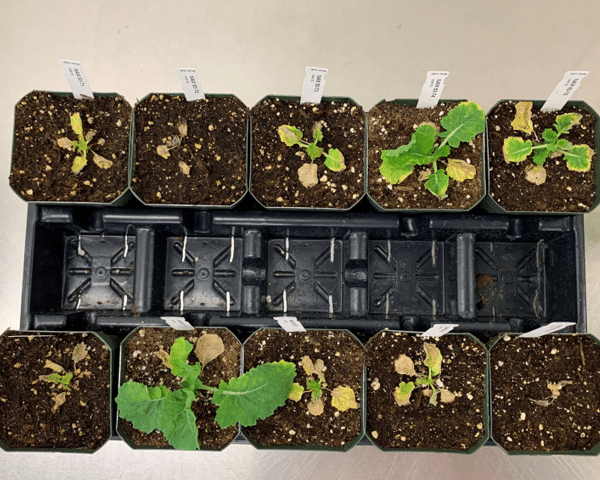Photo credit: Maya Raad (showcasing verticillium stripe research)
The Canola Research Hub features many projects (completed and ongoing) from the Canola Agronomic Research Program (CARP), which is a collaborative research initiative funded by Alberta Canola, SaskCanola, and the Manitoba Canola Growers, and administered by the Canola Council of Canada. Since its establishment in 1985, CARP research has continued focused on helping canola farmers increase yield and profitability, reduce production risks and enhance sustainability.

Canola Agronomic Research Program (CARP) projects
To see which topics are covered in CARP research check out:
Learn more about CARP and differentiate it from CAP with the Research-funders-What are CARP and CAP? Hub blog.
Research priorities to inform CARP 2023

Although projects selected for CARP 2022 only officially began on April 1st, 2022, preparations are already underway for CARP 2023. Letters of Intent (LOIs) for 2023 CARP are now being accepted by the CCC on behalf of the three prairie canola grower associations until July 18th, 2022. Submission details and contact options are available this Canola Agronomic Research Program page.
To help guide researcher applicants on what is need by these organizations and to prevent any redundancy of projects currently in progress, the organizations involved and the Western Grains Research Foundation (WGRF), which may also be a funding partner for some projects, are sharing their research priorities.
To discover the important areas of focus for these five organizations, which will inform the selection of the CARP 2023 project, see their research priorities:
- Alberta Canola
- Manitoba Canola Growers
- SaskCanola
- Western Grains Research Foundation
- Canola Council of Canada
Crop production research priorities
The Canola Council of Canada’s thorough crop production research priorities, which are updated annually (which prevents any duplication of efforts on topics that received funded over the past year) through consultation with industry, expert steering groups, and the annual Canola Week event are provided below:
Sustainability
- Determine the economic and production impact of climate change and landscape modification.
- Model canola’s carbon sequestration potential and investigate areas for improvement.
- Evaluate and identify alternative management tactics and tools for major canola pests.
- Understanding the production and environmental risks and benefits of tile drainage systems.
- Evaluate the economic, environmental, and production feasibility of cover crops to canola production systems.
- Discover water use efficiency improvements (ex. genetic, agronomic, irrigation management).
- Evaluate the role of canola’s microbiome in carbon sequestration.
Insect pests
- Evaluate and identify alternative management tactics and tools for major canola pests.
- Technology and strategies to reduce off-target impacts of foliar insecticides and improve their efficacy.
- Insect pest monitoring and surveillance.
Weeds
- Weed monitoring and surveillance, modelling of weed species shifts in a changing climate.
- Investigate and identify novel integrated weed management techniques for enhanced and diversified weed control methods.
Sclerotinia stem rot
- Development of sclerotinia stem rot resistance in canola by incorporating resistance into parental lines & hybrids.
- Identification of genes and defense pathways underlying quantitative resistance to S. sclerotiorum in canola.
- Evaluate and improve epidemiological models for forecasting sclerotinia stem rot outbreaks and improve risks models based on real time data.
- Development of rapid in-field S. sclerotiorum presence testing.
- Measure new fungicides and other sclerotinia management products for placement on a comprehensive universal sclerotinia control scale/label.
- Optimize foliar fungicide efficacy for control of sclerotinia stem rot. Evaluate economic threshold of application.
Clubroot
- Develop a plan to maintain the utility of clubroot resistance in the long term.
- Understand the genetics of resistance and develop durable resistance sources.
- Identify new methods to decrease P. brassicae spore/inoculum loads in the soil and develop methods to maintain canola productivity in face of clubroot.
- Improvements to producing, purifying, and distributing P. brassicae single spore isolates.
- Improved methods of early detection, sampling, and identification of P. brassicae specific pathotypes in a field.
Blackleg
- Testing the effectiveness of resistant varieties post-registration across the prairies.
- Exploration of novel resistance genes in B genome and resistance genomes.
- Evaluation of novel techniques and technologies to effectively manage blackleg in a typical canola rotation.
- Using novel technologies that transfer resistance genes from B or resistance genome efficiently into B. napus canola without relying on conventional GMO approaches.
- Quantifying the impact of crop rotation and crop species on inoculum pressure and disease severity.
Verticillium stripe
- Standardized protocol for molecular diagnostics of V. longisporum.
- Cultural controls for effective management of V. longisporum.
Liming
- Evaluate the impact of pH stratification and/or acid soils on crop production.
- Technology for pH amendment in zero till production systems.
Harvest management
- Improve upon and test combine loss and yield sensor technology.
Storage
- Development of best management practices for storage of canola in large bins (>10,000 bushel).
- Evaluation of alternative conditioning and drying methods/technologies and fan control systems for reduced energy requirements.
- Malathion breakdown and uptake by canola seeds in storage.
- Impact of seed respiration, elevated dockage, green seed, and immature seed on storability.
Plant establishment
- Investigate and quantify agronomic and management factors impacting canola germination and yield potential (ex. harrowing and micro-tillage operations).
- Understand and quantify soil microbiological factors that impact B. napus germination and emergence.
Precision agriculture
- Survey and understanding of commercial precision agricultural tools available to producers to make better predictions of weather and pest impacts.
- Feasibility of polarimetric LiDAR and Landsat data to provide crop growth information to aid in growing season decision making.
- One-pass seeding system optimization and design.
- Evaluation of technology and tools to reduce reliance on foliar pesticides while improving productivity.
- Feasibility of managing field variability through big data, algorithms, and climate / weather prediction models.
Profitability
- Regional assessment and comparison on canola profitability.
- Reassess the “5% Rule” for canola production.
- Evaluation on incremental ROI from recommended agronomic practices.
- Strategies to improve profitability with increased production costs.
Crop Nutrition and Fertility Management
- Quantify the opportunities for improved yield with enhanced efficiency fertilizer sources.
- Quantify societal, environmental, and on-farm economics of 4R management adoption.
- Update the impact of background P2O5 and Potassium levels on canola yield.
- Investigate nutrient management opportunities to improve yield stability with a changing climate.
- Evaluate the need for / role of micronutrients in very high-yielding canola.
- Assessment of sulphate release over time from new elemental sulphur formulations.
- Evaluate validity of current fertility recommendation models for hybrid canola under long-term zero till production.
- Evaluate alternative methods of soil sampling and analysis that lead to efficient and accurate analysis.
- Evaluate utility of proximal sensors/ imaging techniques for nutrient availability predictions and improved precision fertilization.
- Evaluate and optimize biological nitrogen fixation regime in canola.
- Evaluate the impact of frequent canola rotations on soil health.
- Evaluate the effect of acidification of soils and incidence of Mn toxicity based on different soil properties.
- Quantify production impacts on soil organic matter depletion and accumulation.
For more details on this, see the Crop Production Research Priorities.
Published June 16, 2022








